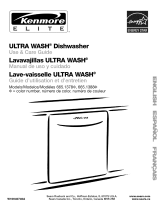
START |
Before You Start
• Do not pre-rinse. Simply scrape off any bones or
large food particles.
• If you have a food waste disposer make certain that
the disposer is empty before starting the dishwasher.
• Periodically check the coarse filter cup and empty if
necessary before starting the dishwasher (see page 17).
• Scrape off tomato-based food soils (see page 16).
• Remove certain foods such as mustard, mayonnaise,
lemon juice, vinegar, salt or dressings from stainless
steel flatware as soon as possible. These foods may
cause rusting and pitting if allowed to remain in
contact with the surface of the flatware for an
extended period of time.
Rinse Aid
important: This dishwasher is designed to use a
liquid rinse aid. Rinse aid greatly improves drying,
reduces spotting and filming, and reduces
moisture left on the dishwasher interior by
creating a "sheeting" action. Water "sheets" off
dishes, preventing drops of water from remaining
on dishes and creating spots. Drying performance
will improve after several washes using rinse aid.
An automatic rinse aid dispenser is located next to the
detergent cup.
An illuminated light on the control panel indicates
when the rinse aid reservoir needs to be refilled. Check
the dispenser monthly. To fill and adjust the amount of
rinse aid dispensed into the dishwasher, see page 10.
Hot Water
For optimal cleaning and drying results, hot water is
necessary. The incoming water temperature should be
120° F (49° C[}to properly activate the detergent and
melt greasy food soils.
To check the incoming water temperature, turn on the
hot water faucet nearest the dishwasher and let it run
into a glass in the sink. Place a candy thermometer in
the glass and check the temperature once it has
stopped rising.
Starting the Dishwasher
1. Check that the coarse filter cup is securely in place
(see page 17).
2. Load the dishwasher and add detergent.
3. Select the desired cycle and options by pressing the
pads on the control panel. The indicator lights for the
.
selected cycle and options will illuminate. To cancel a
cycle or select another cycle, press the Cancel/Drain
pad. To cancel an option, press the option pad again,
or press the Cancel/Drain pad.
To start a cycle, press the StarUResume pad once,
then close the drawer. After a brief pause, the cycle
will begin. To prevent unplanned cycle or option
changes, these selections are "locked in" after the
initial fill is complete.
Notes:
• If Start/Resume is not pressed within 30 seconds of
choosing a cycle, the dishwasher will turn off.
• Press the Start/Resume pad once, then close
the drawer. Drawer must be closed within 3
seconds after pushing Start/Resume or the lights
will flash and the audio alarm sound will be
heard. After closing the drawer there will be a
brief pause before the cycle begins.
The dishwasher remembers your last cycle so you do
not have to reset the cycle each time. To start the
dishwasher using the same cycle and options
selected on the previous wash, just press the
Start/Resume pad.
5. To cancel a running cycle, press the Cancel/Drain
pad once. The dishwasher will drain, then shut off.
To turn the dishwasher off without draining, press the
Cancel/Drain pad twice.
Notes:
• If a cycle pad is pressed after the controls have been
"locked in",the light above the current cycle will flash
three times and an audible beep will be heard.
• If you have a two-drawer dishwasher model, each
drawer has its own controls and can run
independently of the other.
Adding a Forgotten item
For best cleaning, the forgotten item should be added
early in the cycle.
1. Grasp drawer handle and open drawer. An audible
beep will sound to indicate the drawer is open and
the cycle has been suspended.
2. With the drawer open, add the item.
3. Press Start/Resume then close the drawer.
Note: Extended interruption of the wash cycle is
not recommended.
I
6
























